-

新人教版高中英语选修2Unit 4 Reading for writing教学设计
假定你是英国的Jack,打算来中国旅行,请你给你的中国笔友李华写一封信,要点如下:1.你的旅行计划:北京→泰山→杭州;2.征求建议并询问他是否愿意充当你的导游。注意:1.词数80左右(开头和结尾已给出,不计入总词数);2.可以适当增加细节,以使行文连贯。参考词汇:故宫 the Forbidden City;泰山 Mount TaiDear Li Hua,I'm glad to tell you that 'm going to visit China.First,I am planning to visit Beijing,the capitalof China,where I am looking forward to enjoying the Great Wall,the Forbidden City and somebeautiful parks.Then I intend to go to visit Mount Tai in Shandong Province.I've heard that it is one ofthe most famous mountains in China and I can't wait to enjoy the amazing sunrise there.After that,I amalso going to Hangzhou.It is said that it is a beautiful modern city with breathtaking natural sights,among which the West Lake is a well- known tourist attraction.What do you think of my travel plan? Will you act as my guide? Hope to hear from you soon.

新人教版高中英语选修2Unit 4 Using langauge-Listening教学设计
The theme of the listening section is " talking about scenery and culture along a journey."The part is designed to further lead the students to understand Canadian natural geography and social environment, and integrated into the cultural contrast by mentioning the long train journey from Beijing to Moscow routes. On this basis, the part activates students related travel experience, lets the student serial dialogue, guides the student to explore further the pleasure and meaning of the long journey, and Chinese and foreign cultural comparison.The part also provides a framework for the continuation of the dialogue, which is designed to provide a framework for students to successfully complete their oral expressions, and to incorporate an important trading strategy to end the dialogue naturally.1. Help students to understand and master some common English idioms in the context, and experience the expression effect of English idioms.2. Guide the students to understand the identity of different people in the listening context, and finish the dialogue according to their own experience.3. Instruct the students to use appropriate language to express surprise and curiosity about space and place in the dialogue, and master the oral strategy of ending the dialogue naturally.1. Instruct students to grasp the key information and important details of the dialogue.2. Instruct students to conduct a similar talk on the relevant topic.

新人教版高中英语选修2Unit 5 Learning about Language教学设计
The purpose of this section of vocabulary exercises is to consolidate the key words in the first part of the reading text, let the students write the words according to the English definition, and focus on the detection of the meaning and spelling of the new words. The teaching design includes use English definition to explain words, which is conducive to improving students' interest in vocabulary learning, cultivating their sense of English language and thinking in English, and making students willing to use this method to better grasp the meaning of words, expand their vocabulary, and improve their ability of vocabulary application. Besides, the design offers more context including sentences and short passage for students to practice words flexibly.1. Guide students to understand and consolidate the meaning and usage of the vocabulary in the context, 2. Guide the students to use the unit topic vocabulary in a richer context3. Let the students sort out and accumulate the accumulated vocabulary, establishes the semantic connection between the vocabulary,4. Enable students to understand and master the vocabulary more effectivelyGuiding the Ss to use unit topic words and the sentence patterns in a richer context.Step1: Read the passage about chemical burns and fill in the blanks with the correct forms of the words in the box.

新人教版高中英语选修2Unit 5 Reading and thinking教学设计
The theme of this activity is to learn the first aid knowledge of burns. Burns is common in life, but there are some misunderstandings in manual treatment. This activity provides students with correct first aid methods, so as not to take them for granted in an emergency. This section guides students to analyze the causes of scald and help students avoid such things. From the perspective of text structure and collaborative features, the text is expository. Expository, with explanation as the main way of expression, transmits knowledge and information to readers by analyzing concepts and elaborating examples. This text arranges the information in logical order, clearly presents three parts of the content through the subtitle, accurately describes the causes, types, characteristics and first aid measures of burns, and some paragraphs use topic sentences to summarize the main idea, and the level is very clear.1. Guide students to understand the causes, types, characteristics and first aid methods of burns, through reading2. Enhance students’ ability to deal withburnss and their awareness of burns prevention3. Enable students to improve the ability to judge the types of texts accurately and to master the characteristics and writing techniques of expository texts.Guide students to understand the causes, types, characteristics and first aid methods of burns, through readingStep1: Lead in by discussing the related topic:1. What first-aid techniques do you know of ?CPR; mouth to mouth artificial respiration; the Heimlich Manoeuvre

新人教版高中英语选修2Unit 5 Using langauge-Listening教学设计
The theme of this section is to learn how to make emergency calls. Students should learn how to make emergency calls not only in China, but also in foreign countries in English, so that they can be prepared for future situations outside the home.The emergency telephone number is a vital hotline, which should be the most clear, rapid and effective communication with the acute operator.This section helps students to understand the emergency calls in some countries and the precautions for making emergency calls. Through the study of this section, students can accumulate common expressions and sentence patterns in this context. 1.Help students accumulate emergency telephone numbers in different countries and learn more about first aid2.Guide the students to understand the contents and instructions of the telephone, grasp the characteristics of the emergency telephone and the requirements of the emergency telephone.3.Guide students to understand the first aid instructions of the operators.4.Enable Ss to make simulated emergency calls with their partners in the language they have learned1. Instruct students to grasp the key information and important details of the dialogue.2. Instruct students to conduct a similar talk on the relevant topic.Step1:Look and discuss:Match the pictures below to the medical emergencies, and then discuss the questions in groups.
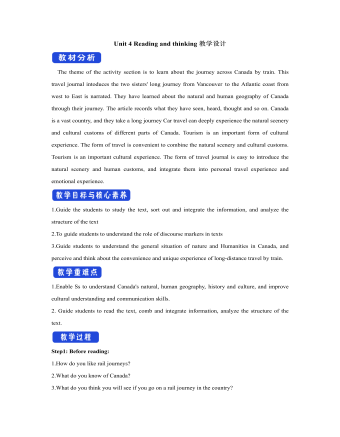
新人教版高中英语选修2Unit 4 Reading and thinking教学设计
【词汇精讲】highlight n.最好或最精彩的部分 vt.突出;强调;使醒目One of the highlights of the trip was seeing the Taj Mahal.这次旅行的亮点之一是参观泰姬陵。Your resume should highlight your skills and achievements.你的简历应该突出你的技能和成就。The report highlights the major problems facing society today.报告强调了当今社会所面临的主要问题。I’ve highlighted the important passages in yellow.我用黄色标出了重要段落。7.Edmonton is freezing cold in winter,with daily temperatures averaging -10 ℃.埃德蒙顿冬季寒冷,日平均气温为-10°C。【词汇精讲】freezing adj.极冷的;冰冻的Leave a basin of water outside in freezing weather.在冰冻的天气里,放一盆水在室外。It’s freezing cold outside so wear a warm coat.外面超冷的,所以穿一个暖和一点的外套吧。8.It was not until 9:30 a.m.that they finally reached the capital of Ontario,Toronto.直到上午9时30分,他们才终于到达多伦多的首府安大略省。【句式剖析】本句是一个强调句,强调的是句子的时间状语until 9:30。含有not...until...的句子的强调句为It is not until...that...,that后面的句子要用肯定形式。It was not until then that I suddenly realized nobody was happier than I was.直到那时我才突然意识到没有人比我更幸福了。
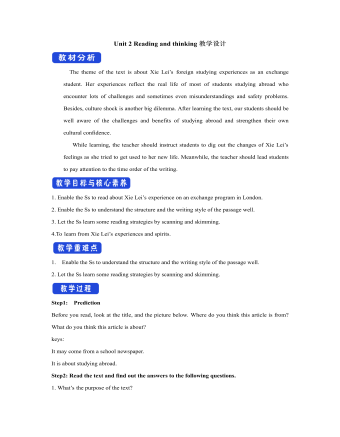
新人教版高中英语选修2Unit 2 Reading and thinking教学设计
Her tutor told her to acknowledge __________ other people had said if she cited their ideas, and advised her _______(read) lots of information in order to form __________wise opinion of her own.Now halfway __________ her exchange year, Xie Lei felt much more at home in the UK. She said __________ (engage) in British culture had helped and that she had been__________ (involve) in social activities. She also said while learning about business, she was acting as a cultural messenger __________(build) a bridge between the two countries. keys:Xie Lei, a 19yearold Chinese student, said goodbye to her family and friends in China and boarded (board) a plane for London six months ago in order to get a business qualification. She was ambitious(ambition) to set up a business after graduation. It was the first time that she had left (leave) home.At first, Xie Lei had to adapt to life in a different country. She chose to live with a host family, who can help with her adaptation (adapt) to the new culture. When she missed home, she felt comforted (comfort) to have a second family. Also Xie Lei had to satisfy academic requirements. Her tutor told her to acknowledge what other people had said if she cited their ideas, and advised her to read lots of information in order to form a wise opinion of her own.Now halfway through her exchange year, Xie Lei felt much more at home in the UK. She said engaging (engage) in British culture had helped and that she had been involved (involve) in social activities. She also said while learning about business, she was acting as a cultural messenger building a bridge between the two countries.
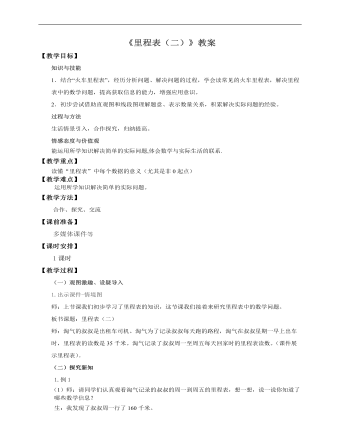
小学数学北师大版三年级上册《第五课里程表(二)》教案说课稿
(一)观图激趣、设疑导入 1.出示课件-情境图师:上节课我们初步学习了里程表的知识,这节课我们接着来研究里程表中的数学问题。板书课题:里程表(二)师:淘气的叔叔是出租车司机。淘气为了记录叔叔每天跑的路程,淘气在叔叔星期一早上出车时,里程表的读数是35千米。淘气记录了叔叔周一至周五每天回家时的里程表读数。(课件展示里程表)。(二)探究新知1.例1(1)师:请同学们认真观看淘气记录的叔叔的周一到周五的里程表,想一想,说一说你知道了哪些数学信息?生:我发现了叔叔周一行了160千米。 师:同学们他说找到数学信息对吗?生:160千米不是星期一的行驶里程,应该是星期一晚上里程表上的读数。 星期二里程表上的读数是350,。生:。。。。师:同学们找的数学信息非常多,非常全面。(2)小组讨论交流:淘气根据题意画了一个图,你看懂了吗?与同伴说一说。

人教部编版语文八年级上册蝉教案
鲁迅曾把《昆虫记》称为“讲昆虫的故事”“讲昆虫生活”的楷模。鲁迅说:“他的著作还有两种缺点:一是嗤笑解剖学家,二是用人类道德于昆虫界。”周作人说:“法布尔的书中所讲的是昆虫的生活,但我们读了却觉得比看那些无聊的小说戏剧更有趣味,更有意义。”巴金说:“《昆虫记》融作者毕生的研究成果和人生感悟于一炉,以人性观照虫性,将昆虫世界化作供人类获取知识、趣味、美感和思想的美文。”传统文化玉蝉:蝉意喻人生蝉在古人的心目中地位很高,向来被视为纯洁、清高、通灵的象征。玉蝉究其用途,大体可分为四种:一是佩蝉,是专门佩戴在人身上以作装饰和避邪用,示高洁;一种为冠蝉,是作为饰物缀于帽子上的,表示高贵;一种是琀蝉,以蝉的羽化比喻人能重生,寓指精神不死,再生复活;还有一种是镇蝉,做镇纸用的文房用品,多出现在明代以后,前三种蝉属于高古玉,主要产生在商周至战汉时期。
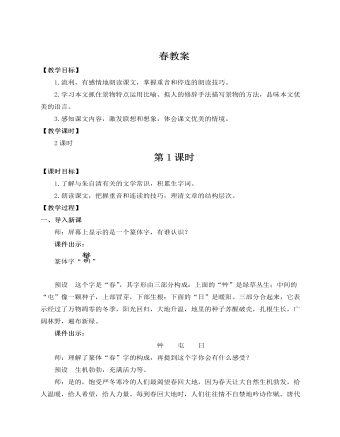
人教部编版七年级语文上册春教案
本文具有很强的画面感,凸显出绘画美,虽是散文,却满贮诗意,正是文中有画,画中有诗。作者从色泽、层次和动态上向人们展示了一幅栩栩如生的春景图。作者笔下的春景图色泽鲜艳,不仅有象征希望的“嫩嫩的,绿绿的”小草,还有“红的像火,粉的像霞,白的像雪”的繁花,也有温暖的“红红的”太阳的脸和“黄晕的”灯光,这些色彩描绘出了一个生机勃勃而又安静祥和的春天。在描写春景的时候,作者还通过有层次感的描写使景物意蕴悠长,例如对春雨的描写是从“人家屋顶上”到“小路上”“石桥边”再到“地里”,从远至近,层次分明。另外,朱自清使用精妙的语言向读者展示了动态(生机)美,在他笔下,花是“赶趟儿”的,蜜蜂是“闹着”的,气味儿是“酝酿”的,一切都是“生长着”的,洋溢着盎然的生机。作者从总体上描绘春景,大地回春、万物复苏的景象就活生生地展现在了读者眼前。
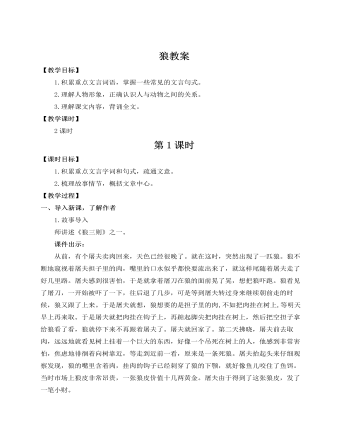
人教部编版七年级语文上册狼教案
(学生交流,教师引导,总结方法)(1)方法1:主谓之间要停顿。【示例】一狼/得骨/止;其一/犬坐于前。(2)方法2 :谓语与宾语之间要停顿。【示例】顾/野有麦场;乃悟/前狼/假寐 。(3)方法3:连词前面可以停顿。【示例】后狼止/而前狼又至;意将/隧入/以攻其后也。(4)方法4 :发语词后面要停顿。【示例】盖/以诱敌。(全班齐读课文,读顺文章)师小结:理解文意,固然可以运用停顿技巧,但最重要的方法是弄懂字词大意、文句意思。理解了文意,才能读准句读,有利于我们读顺文章。【设计意图】本环节旨在通过学习互助的方式,调动学生的学习热情,充分发挥学生的学习积极性和主动性,进而理解文意,读顺文章。教师及时点拨,适时归纳文言释词方法、句式和停顿划分小技巧,实现知识学习与技能掌握的统一。四、细读课文,读懂内容1.概括文章情节文章讲述了屠户杀狼的故事。按照事件的发展,情节一般可以分为开端(发生)、发展、高潮和结局。请同学们细读课文后,用词语概括这个故事的发展经过。(生交流后,师明确)
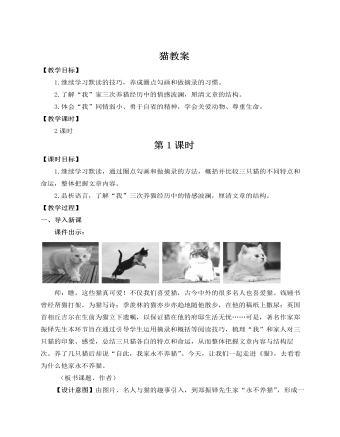
人教部编版七年级语文上册猫教案
【设计意图】此环节聚焦第三只猫的悲剧,让学生通过品析语言,想象猫的内心冤屈,同时结合创作背景,逐层深入地理解课文主题及作者的人文情怀。三、拓展延伸1.同学们,你喜欢文中哪一只猫呢?为什么?(生自由讨论)预设(1)喜欢第一只或第二只猫,因为它好看,性情可爱、活泼。(2)喜欢第三只猫,它更可怜,更需要关爱。(3)都喜欢,因为生命不分高低贵贱,它们是平等的。我们要尊重每一个生命。2.如果你是第三只猫,应该怎么做才能避免悲剧的发生呢?(分组讨论,全班交流。可从“自省”“自强”“完善自我”等角度讨论)预设(1)如果我是第三只猫,首先要自我反省,知道自己哪些方面不够优秀,找到不足,然后不断努力,完善自我。(2)不能埋怨别人,不能自甘堕落,不能放弃自己。结束语:文章以“我家养了好几次猫,结局总是失踪或死亡”总领全文,以“自此,我家永不养猫”收束全文,结构紧凑。文章以猫写人,用猫的世界折射世态人情。
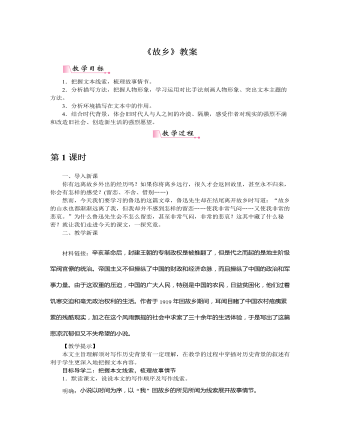
部编版语文九年级上册《故乡》教案
【分析杨二嫂形象】1.昔日的杨二嫂是怎样的一个形象?明确:昔日被称作“豆腐西施”,“擦着白粉”“终日坐着”,是一个安分守己的妇女形象。2.如今的杨二嫂是怎样的形象?作者是从哪些方面刻画的?明确:“凸颧骨”“薄嘴唇”“圆规”等肖像描写,“尖利的怪声”“大叫”“两手搭在髀间”“贵人眼高”等动作和语言描写,表现出了杨二嫂泼悍、放肆、尖刻的性格特征。讨东西、造谣、塞手套又表现出她的自私、泼悍、爱贪小便宜。探究:作者塑造杨二嫂这一形象有什么作用?杨二嫂的形象是作者“悲哀”的源头吗?明确:杨二嫂的变化说明了辛亥革命后,城镇小市民阶层的贫困化,反映了当时社会经济破产的广度和深度。杨二嫂的变化,是不合理制度下的人性转变,如果说闰土是“精神麻木”的状态让作者觉得“悲哀”,那么杨二嫂便是因为失去真善美的人性而使作者觉得“悲哀”。

部编版语文八年级上册《背影》教案
目标导学四:学以致用,学习刻画形象点拨:作者在描写父亲背影的过程中,综合运用了外貌描写与动作描写的方法。在描写外貌时,抓住父亲穿着简陋与肥胖的典型特征,在动作描写中也集中体现出攀月台不易的形象。作者这种抓住典型特征做简要勾画来表现出人物形象的方法叫白描手法。引导:在你的印象中,是否也有人给你留下过如此感动的回忆呢?请你仔细回忆当时的场景,具体到对方做了什么动作,他(她)是什么形象,或说了什么话,将这些记录下来,记住要表现描写对象的主要特征。第2课时一、复习回顾、引入新课在上一课时,我们仔细分析了朱自清先生刻画的“背影”形象,这个形象如此令人感动。然而细心的同学恐怕已经明显地感受到朱先生的情感在文中有着极大的变化,而父亲对孩子的感情也未必就是爬月台买橘子那样简单,这节课,就让我们更加深入地走进本文的情感世界。
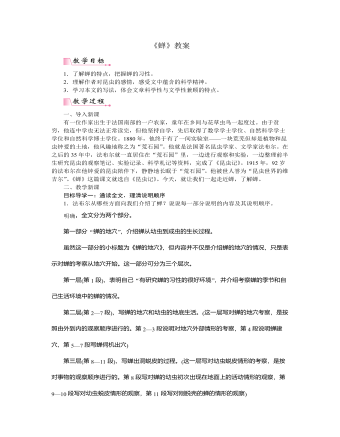
部编版语文八年级上册《蝉》教案
第一层(第12—13段),介绍蝉的产卵,分别说明了产卵的地方、过程和数量等。第二层(第14—17段),写蝉卵遇到的危险,首先说明产卵的数量多是为了在遭到破坏时能有幸存者,然后介绍蚋对蝉卵的破坏和蝉对此的茫然无知。第三层(第18—20段),介绍蝉卵的孵化和幼虫出壳。第四层(第21—23段),写幼虫落地。第五层(第24段),写幼虫挖穴隐藏。第六层(第25—26段),概括蝉的生活历程。既照应了“蝉的地穴”的介绍,又结束了对蝉卵生长过程的说明,也是对全文形象化的总结。目标导学二:默读课文,品味说明语言思考:这是一篇说明文,但我们读起来并不觉得枯燥无味,为什么?明确:《蝉》实质是科学观察笔记、考察报告,属于科学著作的范畴。但是,作者在表达上采用了一些文学性语言对说明对象的科学资料进行综合介绍,因此有一定的文学色彩。其文学色彩主要表现在以下几个方面:
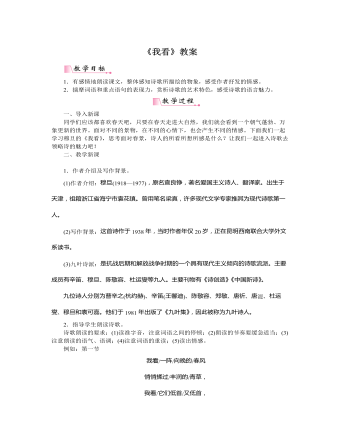
部编版语文九年级上册《我看》教案
目标导学二:再读课文,理解诗意1.品读第一节,思考:第一节包含的意象有哪些?表现了春天大自然的哪些特点?明确:春风、青草。表现了大自然的勃勃生机和美丽生动。2.画出第一节中能表现春风和春草特点的词语,分析它们的表达效果。(可用“以什么修辞或者表现手法表现了什么事物什么特点”的格式来表达)明确:“揉过”“低首”运用拟人的修辞手法,写出了春风吹过草地,小草随风摇曳的情景。“也许远水荡起了一片绿潮”运用比喻的修辞手法,把草地比作“绿潮”,写出了绿草像“潮水”一样涌动,给人带来无限生机和活力。3.品读第二节,思考:第二节紧承第一节哪个词语?第二节描写的意象有哪些?描绘了一幅怎样的画面?明确:紧承第一节的“向晚”。意象:展翅的飞鸟、天边的流云和大地。画面:在黄昏时分,鸟儿在深邃的天空中翱翔,夕阳染红了天边的流云,彩霞铺满天空,也映红了大地。

部编版六年级语文上册《草原》教案
(1)思考:作者是按什么顺序写的?写了哪些内容?明确:作者是按事情发展的先后顺序来写的。首先描述了一望无际的草原美景,使人感受到了一种境界美;接着又展示了主人欢迎远方客人的隆重场面;最后把酒话别,用“蒙汉情深何忍别,天涯碧草话斜阳”来收束全文。(板书:初到草原——远迎客人——热情相见——盛情款待——联欢话别)作者笔下的草原给你留下了什么印象?(学生讨论、交流自己的印象,可与读此文之前对草原的印象进行对比并探讨。)
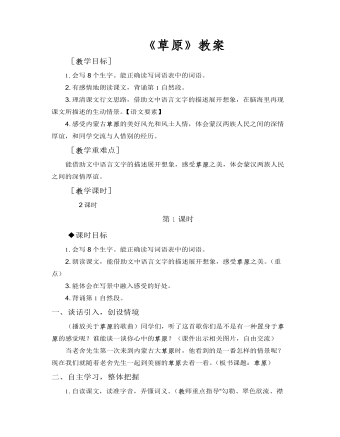
部编版六年级语文上册《草原》教案
1.会写8个生字。能正确读写词语表中的词语。2.朗读课文,能借助文中语言文字的描述展开想象,感受草原之美。(重点)3.能体会在写景中融入感受的好处。4.背诵第1自然段。一、谈话引入,创设情境(播放关于草原的歌曲)同学们,听了这首歌你们是不是有一种置身于草原的感觉呢?谁能谈一谈你心中的草原?(课件出示相关图片,自由交流)当老舍先生第一次来到内蒙古大草原时,他看到的是一番怎样的情景呢?现在我们就随着老舍先生一起到美丽的草原去看一看。(板书课题:草原)
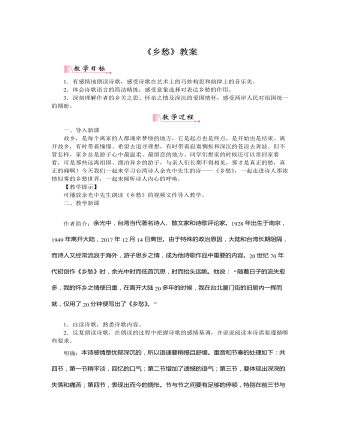
部编版语文九年级上册《乡愁》教案
【教学提示】教师可以示范分析其中两个意象,注意引导学生把握普通事物之所以形成诗歌意象的原因,领悟诗歌意象的内蕴意义。3.诗人在诗中运用了许多表修饰、限制的形容词和数量词,它们有什么特点?它们共同突出了诗歌中四个意象的什么特征?请你简要说说它们在诗歌中的表达效果。明确:“一枚”“一张”“一方”“一湾”四个数量词和“小小的”“窄窄的”“矮矮的”“浅浅的”四个形容词,都是面积小重量轻的词语。然而,邮票虽小,却承载了母子深情;船票虽窄,却联系着夫妻之间浓浓的恋情;矮矮的坟墓,盛不下生死离情之痛;海峡虽浅,隔断的思乡哀愁却是如此之深。这一系列限定修饰词,都反衬了乡愁的浓郁。目标导学四:把握诗歌艺术特征探究:本诗除了在意象选取上颇费心思,在结构艺术上也见出笔力。请同学们说说,本诗还具有哪些令你欣赏的艺术特征。
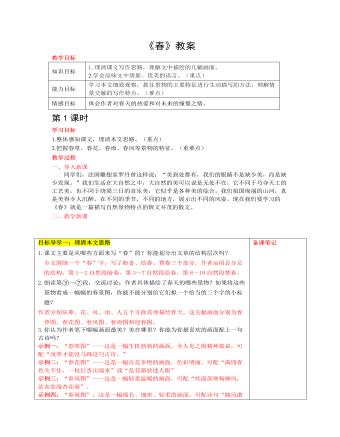
部编版语文七年级上册《春》教案
目标导学一:理清本文思路1.课文主要是从哪些方面来写“春”的?你能划分出文章的结构层次吗?全文围绕一个“春”字,写了盼喜、绘春、赞春三个部分。作者运用总分总的结构,第1—2自然段盼春,第3—7自然段绘春,第8—10自然段赞春。2.细读第③—⑦段,交流讨论:作者具体描绘了春天的哪些景物?如果将这些景物看成一幅幅的春景图,你能不能分别给它们拟一个恰当的三个字的小标题?作者分别从萆、花、风、雨、人五个方面具体描绘春天,这五幅画面分别为春草图、春花图、春风图、春雨图和迎春图。3.你认为作者笔下哪幅画面最美?美在哪里?你能为你最喜欢的画面配上一句古诗吗?示例一:“春草图”——这是一幅生机勃勃的画面,令人见之则精神振奋。可配“浅草才能没马蹄这句古诗。”



